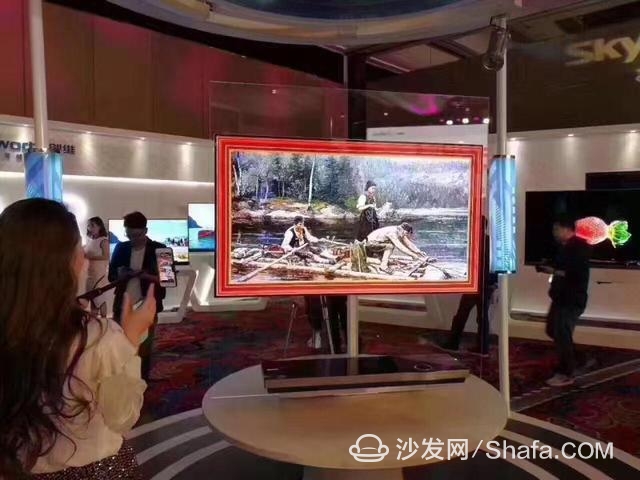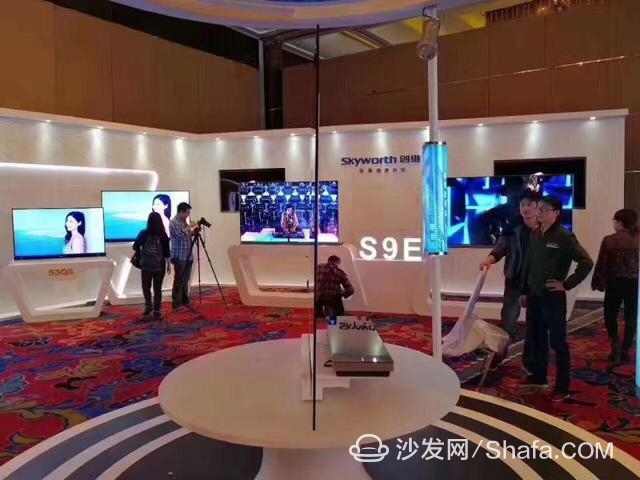This picture frame that looks like oil painting is actually an OLED TV. I have said many times that at present, the only factor that restricts the development of OLED TVs is the last one, that is, the supply of OLED panels is tight. It is expected that this tension will persist for the next three years. This is due to one reason. At present, the manufacture and supply of global large-screen OLED panels rely on an LGD company. Other companies have not yet formed actual production capacity. For example, China's panel giant BOE, although it has launched the first fully autonomous OLED TV in the joint venture Skyworth last year, it has not yet formed a large-scale OLED panel real production capacity. Seeking truth from facts, apart from the panel, OLED TVs have not seen any significant shortcomings. On the contrary, we see OLEDs as a new type of display technology with many revolutionary advantages such as flexible display, self-luminescence, various product forms, and a wide range of applications. Its impressive improvement in the quality of television and the dramatic changes in the form of television are impressive. For example, OLED display technology can be used to create Wallpaper wallpapers, two-sided TVs, transparent TVs, and so on, but LCDs and current quantum dot technology cannot. With such excellent display technology, why is someone always pouring water on it? The cause of the original thing. "OLED TV is easy to burn screen," "OLED TV life is short." In the anti-OLED camp mouth, OLED TV is so unbearable, then, what is the truth in the end? The so-called “burning†of the anti-OLED camp does not mean that the OLED TV screen will burn, but that the OLED TV displays a fixed screen for a long time will leave a residual image on the screen. It is said that this is a problem unique to early plasma TVs. However, this situation has not occurred in the mainstream brand OLED TV, at least we did not see the relevant reports. In this regard, the global OLED TV leader LGD has the most say, and we see how it is explained. At the "OLED media conference" held on October 27, 2016, LGD and Skyworth conducted technical explanations specifically for the "burning screen" and "lifetime" issues of concern to the public. It is said that the OLED TVs launched by LGD and Skyworth can ensure the viewing of 10,000 hours without the “burn-in†phenomenon by adopting an image quality improvement algorithm and improving component characteristics. In other words, even if watching 5.5 hours of CCTV programs every day and continuing to watch for 5 years, the brightness of the screen at the “CCTV†sign is only reduced by 5%, and there will be no afterimage. In fact, no one has watched TV shows on the same channel for so long. OLED in the end there is no residual image? I would suggest that it might be a good idea to see the truth - go to the TV store and take a look at how the picture of the OLED TV behaves. You have the most authoritative answer. If you find that there is an afterimage, you must take photos to preserve the evidence so that you can use it to advertise in the media and put OLED TVs to death. Let's talk about the "lifetime" of OLED TVs. Both Skyworth and LGD promise that the current lifespan of OLED TVs currently on the market is more than 50,000 hours. What is the concept of 50000 hours? That is, even if you watch 8 hours of TV every day, you can be sure that you use it for 17 years. Do you know how many years the country's regulations for the normal service life of television are? In 8 years, the service life of OLED TVs was as long as 17 years. It seems to me not too short but too long. Therefore, I suggest that the anti-OLED camp plan it well and attack the OLED too long as its shortcomings. You said that the long life of OLED TVs not only increases technical difficulty and manufacturing costs, but also may promote the application of new technologies. Obstruction. A little note that you will notice that the anti-OLED camp's attacks on OLEDs mostly remain at the hearsay level. Others say that "burning the screen" I say burn screen. Others say that "short life span" I say that life is short, others say "good rate" Low, "I said that the yield is low. As for the truth, I don't care. I have a trick for the anti-OLED camp: Before you attack OLED, you must be willing to spend money to buy an OLED TV. Think about it and see if there are any obvious flaws. Then go for a targeted attack. It will cause people to lose confidence in the anti-OLED camp. If you can't afford an OLED TV, you can buy an OLED screen phone and see if it will burn. If you can't afford to buy a mobile phone, you can always walk around to the appliance store. If you don't even do this, please ask: What is the basis for you to pick up the OLED? Is it based solely on prejudice? My estimation is due to two possibilities: 1. I have listened to the misleading propaganda of the anti-OLED camp, knowing that it is wrong and not correcting it; 2. It is the anti-OLED camp itself. Anti-OLED is in your interest. There is no third possibility beyond that. The "line" in the middle is actually a TV viewed from the side and viewed from the front, which is Wallpaper wallpaper TV In fact, if OLED is really good or not, it will be easy to use it. It is a definite fact that since the listing in 2013, we have never seen the media report about OLED TV burn-in. There is no specific case. If burn-in is a common phenomenon, why can't we see related reports? From another point of view, if burn-in occurs from time to time, not to mention TV manufacturers have long abandoned this technology, I am afraid that only to deal with consumer complaints and claims, manufacturers can not stand. What's more, international brands like Sony are extremely serious about the choice of products and technology routes. How can one choose a product that is not good enough? So, what exactly does OLED do? If you think about it, you know who is lying. Some people may ask: Since OLED is so excellent, why does the anti-OLED camp resolutely do not turn to OLED to seek the direction of quantum dots? I must say that this question is a good one! Let me tell you why. At present, there are three representative companies in the global anti-OLED camp: Samsung, Hisense, and TCL. I'll give you an analysis. Samsung's shift from the OLED camp to the anti-OLED camp in 2012 was due to the delay in breaking through the mass production technology of large-screen OLED panels, but it did not want to give competitors (mainly LGD) a sedan chair. What should we do? After thinking about it, I decided to introduce the quantum dot concept. The problem is that quantum dots are still essentially liquid crystal, which means that there is no substantial progress in the technological path. Hisense persisted in laser television because its chief executive, Zhou Houjian, "deemed" this technical direction 10 years ago. Since it is the direction of the big boss, the following is only to cater to the preference; the direction of Quantum was turned towards the beginning of this year because of Hisense. Trying to do a variety of ways and can not get OLED panel resources, turned to Quantum camp in angrily. As for TCL's choice of quantum dot routes, it is easier to understand. LCD panel industry is the TCL Group's profit cows, TCL of course do not want the LCD era ended too early, after all, OLED is born leather LCD life. Understand it, color TV companies choose what direction, it is the result of comprehensive consideration of various factors, does not entirely depend on the judgment of the direction of the industry. Some people turned around for OLED, and some people refused to turn around for OLED. In fact, it is understandable. This is what we often say, "Bottom decides the head." At the 2017 China (International) Flat Panel Display Industry Conference held on April 9th, LGD and Samsung’s two major allies directly confronted each other. Li Tinghan, vice president of LGD Global Promotion, gave a speech titled “OLED, Change Your Lifestyleâ€. He said: The commercialized QLED technology on the market is the same as the existing LCD technology. Luminescence technology; and everyone recognized QLED is different from this, is the same self-luminous technology with OLED. However, the industry believes that it takes more than five years to develop QLED materials and more than 10 years for equipment development and stabilization. "All new technologies will take a while to mature, and OLEDs are already commercialized. Many OLED-equipped products are commercialized. Therefore, compared with QLEDs, mature OLEDs will be faster to preempt market. Li Tinghan "OLED represents the future, not afraid of spoiling" voice just dropped, Samsung Display Vice President OS YANG is the theme of "QD LCD: The Future of Television" speech, and Li Tinghan's point of view. Some participants stated that compared with the former, the expression of the latter seems insufficient. Smart TV/box information can focus on smart TV information network sofa butler (http://), China's influential TV box and smart TV website, providing information, communication, TV boxes, smart TVs, smart TV software, etc. Answering questions. Disposable Vape Pen,Disposable Vapor Pen,Disposable Vapes,Vape Disposable Pod Shenzhen Xcool Vapor Technology Co.,Ltd , https://www.szxcoolvape.com

I'll teach you how to destroy OLEDs, but don't move your bricks to your feet
Contrasting with the rapid expansion of OLED TVs is the smashing of OLED TVs by the anti-OLED camp, what “burnsâ€, “short lifeâ€, “low yieldâ€, and so on. If you ask him: Since OLED is so unbearable, why are there so many mobile phone manufacturers upgrading their LCD screens to OLED screens? Why do so many international brands rush to launch OLED TV? They are often speechless. In fact, many people who attack OLEDs have not seen OLED TVs.